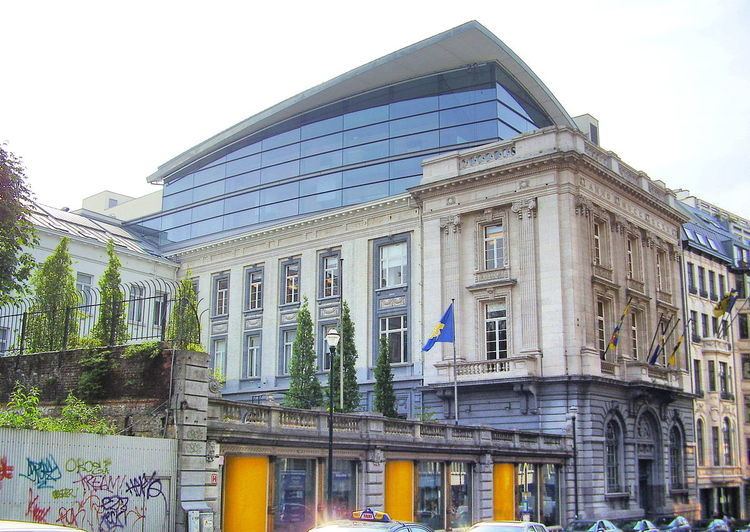 | ||
Similar Espace Léopold, Palais de la Nation, Jeanneke Pis, Brussels Town Hall, Belgian Comic Strip Center | ||
The Brussels Parliament building is a neoclassical building located on Rue de Lombardstraat and houses the Parliament of the Brussels-Capital Region.It largely dates back to the early twentieth century, although it has had some wings date back to the seventeenth century and certain later renovations.
Contents
Architecture
The hemicycle is on the top floor of the building, with the roof being of modern zinc and glass design. The chamber is encircled by a long curved wooden wall and there is an overhanging press and public gallery. Committee rooms have likewise been updated with modern technology but much of the building remains neoclassical. There is also a cafeteria and reading room for deputies. The four rear wings have administrative functions, including housing the Presidents offices. There is also 400 square metres of hanging gardens extending to heights of up to 27 metres.
History
Towards the end of the 17th century, the site housed the vast mansion of the Maes family on the Rue de Chêne. This was destroyed in 1695 by Louis XIV during his bombardment of Brussels in the War of the Grand Alliance. The remains of the mansion and its lands were bought by the Count of Limminghe, Charles van den Berghe, who held numerous posts of administration in Brussels, being twice burgomaster of the city (later mayor). A year later in 1696 he built another large, prestigious two-story mansion at the end of an enclosed courtyard with a garden (entered via Saint-Jean/Sint-Jan). This was then sold on to various figures such as Apostolic Nuncio and the then-ambassador to England.
It was acquired by the state for the first time in 1823 when the Brabant Province and the Dutch State bought it to house the Brabant government and act as the official residence of the local governor. This situation continued after the independence of Belgium in the 1830s however due to development of the provincial government the building became too small and dilapidated by the end of the 1860s. Hence there were successive waves of reconstruction - albeit with a planned design for consistency. The governors residence began to be modified in 1885 and in 1907 the office wing was replaced. Georges Hano, the then-architect for the Ministry of Public Works, built a higher wing with direct access to the rue de Chêne/Eikstraat. The different buildings were also interlinked and the façades overlooking the courtyard were unified. The governors residence was increased one story on the side facing the courtyard and the height was also increased on the building surmounting the porch reconstructed by Hansotte. The new rue du Lombardstraat was opened up by the city at the start of the twentieth century and Hano desired to make the presence of the provincial government felt on this new road which the his complex now bordered. In 1913 works began on a new building, completed in 1930, in a neo-Louis-XVI-style with a ceremonial entrance hall and lavish decoration.
In 1995, Brussels was split from Brabrant and given its own regional government. The Federal government gave the building to the Brussels-Capital region who gave it to the Brussels Regional Parliament, who were searching for a seat. However it became apparent that the buildings were unsuited for the role of a Parliament, leading to the opening of an architecture competition later that year. The resulting changes made including increasing the height of the building wing that overlooked rue du Lombardstraat in order to erect a new hemicycle there on the top floor. This added a large modern roof element to the neo-classical design of the building. Committee rooms were given modern equipment and state rooms were restored. Despite the renovation to the building, the original dimensions have been retained. There was also a multipurpose hall built beneath a hanging garden to create a link between the different sections of the building.
Art
Since being taken over by the Brussels Region, the building has hosted various modern works of art. This is maintained by a commission who purchase the works for the Parliament. The Commission is composed of members of the Parliament Office together with eight external observers from the art world. In 1998, this commission entrusted 11 artists to create works for areas of the building;
